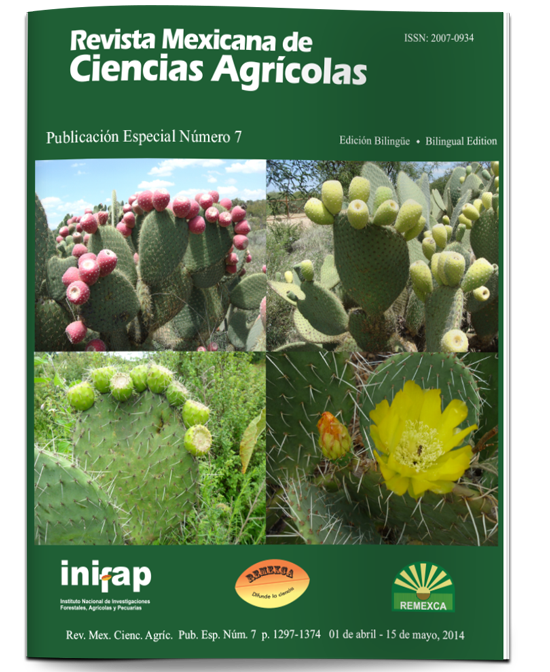‘Invierno’, cultivar of xoconostle for central Mexico
DOI:
https://doi.org/10.29312/remexca.v0i7.1122Keywords:
Opuntia tezontepecana Gallegos & Scheinvar, nutritional quality, variety of commonly used performanceAbstract
A new horticultural form of the genus Opuntia described by Miller (Cactaceae), located in the municipality of Villa de Tezontepec, State of Hidalgo, Mexico, known as xononostle ‘Invierno’. Was evaluated from 2008 to 2010 and found that their mature pads are broadly elliptic, with 8-9 series of borders, with 3-4 spines by areola; blooms once a year and its commercialmaturityisreachedinthemonthofAprilnextyear that f lowering occurs. The fruit of ‘Invierno’ is medium (76.2 cm) in size and oval, with slightly sunken f loral scar epidermis with bright light green with red-orange spots, salmon walls, wide (10.3 mm, characteristic of xoconostles), acidic (pH 4.3), semi-dry to dry and tasteless funiculus orange, firm, medium juiciness and low sugar content (4.4 °Brix) and with few fully developed seeds (137). The average yield on three-year evaluation was 8 727 kg ha-1 and remain off for more than 15 months on the ground, af ter the onset of ripening, which gives it a comparative advantage over varieties xoconostle cuaresmeño Manzano and grown in central Mexico. This variety is being validated under the conditions of Villa Tezontepec, Hidalgo and Calera, Zacatecas to establish their suitability and potential to increase the varietal standard for the commercial production of cactus in the semiarid highlands of Mexico.
Downloads
Downloads
Published
How to Cite
Issue
Section
License
The authors who publish in Revista Mexicana de Ciencias Agrícolas accept the following conditions:
In accordance with copyright laws, Revista Mexicana de Ciencias Agrícolas recognizes and respects the authors’ moral right and ownership of property rights which will be transferred to the journal for dissemination in open access. Invariably, all the authors have to sign a letter of transfer of property rights and of originality of the article to Instituto Nacional de Investigaciones Forestales, Agrícolas y Pecuarias (INIFAP) [National Institute of Forestry, Agricultural and Livestock Research]. The author(s) must pay a fee for the reception of articles before proceeding to editorial review.
All the texts published by Revista Mexicana de Ciencias Agrícolas —with no exception— are distributed under a Creative Commons License Attribution-NonCommercial 4.0 International (CC BY-NC 4.0), which allows third parties to use the publication as long as the work’s authorship and its first publication in this journal are mentioned.
The author(s) can enter into independent and additional contractual agreements for the nonexclusive distribution of the version of the article published in Revista Mexicana de Ciencias Agrícolas (for example include it into an institutional repository or publish it in a book) as long as it is clearly and explicitly indicated that the work was published for the first time in Revista Mexicana de Ciencias Agrícolas.
For all the above, the authors shall send the Letter-transfer of Property Rights for the first publication duly filled in and signed by the author(s). This form must be sent as a PDF file to: revista_atm@yahoo.com.mx; cienciasagricola@inifap.gob.mx; remexca2017@gmail.
This work is licensed under a Creative Commons Attribution-Noncommercial 4.0 International license.



